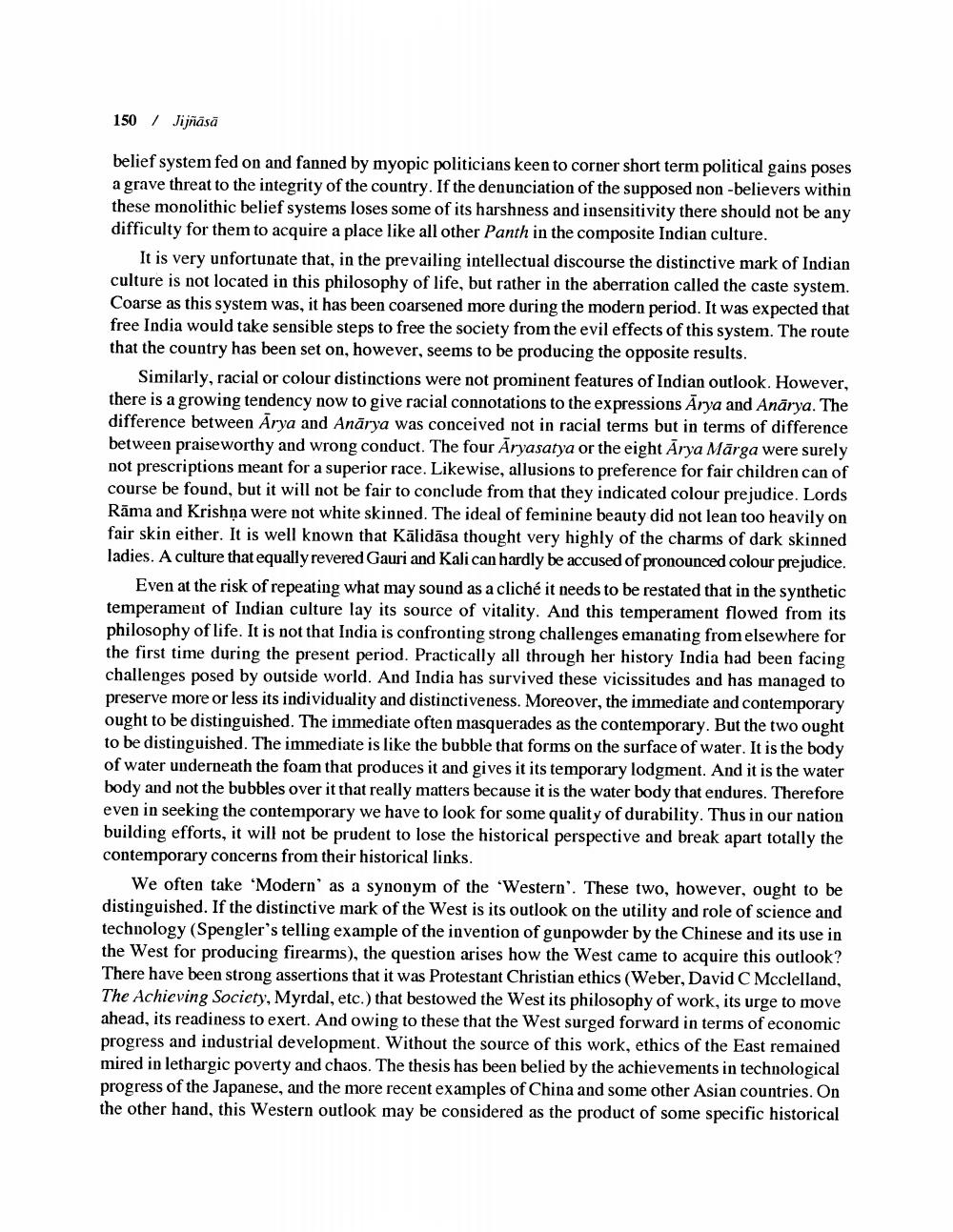________________
150
/
Jijñāsā
belief system fed on and fanned by myopic politicians keen to corner short term political gains poses a grave threat to the integrity of the country. If the denunciation of the supposed non-believers within these monolithic belief systems loses some of its harshness and insensitivity there should not be any difficulty for them to acquire a place like all other Panth in the composite Indian culture.
It is very unfortunate that, in the prevailing intellectual discourse the distinctive mark of Indian culture is not located in this philosophy of life, but rather in the aberration called the caste system. Coarse as this system was, it has been coarsened more during the modern period. It was expected that free India would take sensible steps to free the society from the evil effects of this system. The route that the country has been set on, however, seems to be producing the opposite results.
Similarly, racial or colour distinctions were not prominent features of Indian outlook. However, there is a growing tendency now to give racial connotations to the expressions Arya and Anārya. The difference between Arya and Anārya was conceived not in racial terms but in terms of difference between praiseworthy and wrong conduct. The four Aryasatya or the eight Arya Mārga were surely not prescriptions meant for a superior race. Likewise, allusions to preference for fair children can of course be found, but it will not be fair to conclude from that they indicated colour prejudice. Lords Rāma and Krishna were not white skinned. The ideal of feminine beauty did not lean too heavily on fair skin either. It is well known that Kālidāsa thought very highly of the charms of dark skinned ladies. A culture that equally revered Gauri and Kali can hardly be accused of pronounced colour prejudice.
Even at the risk of repeating what may sound as a cliché it needs to be restated that in the synthetic temperament of Indian culture lay its source of vitality. And this temperament flowed from its philosophy of life. It is not that India is confronting strong challenges emanating from elsewhere for the first time during the present period. Practically all through her history India had been facing challenges posed by outside world. And India has survived these vicissitudes and has managed to preserve more or less its individuality and distinctiveness. Moreover, the immediate and contemporary ought to be distinguished. The immediate often masquerades as the contemporary. But the two ought to be distinguished. The immediate is like the bubble that forms on the surface of water. It is the body of water underneath the foam that produces it and gives it its temporary lodgment. And it is the water body and not the bubbles over it that really matters because it is the water body that endures. Therefore even in seeking the contemporary we have to look for some quality of durability. Thus in our nation building efforts, it will not be prudent to lose the historical perspective and break apart totally the contemporary concerns from their historical links.
We often take 'Modern' as a synonym of the 'Western'. These two, however, ought to be distinguished. If the distinctive mark of the West is its outlook on the utility and role of science and technology (Spengler's telling example of the invention of gunpowder by the Chinese and its use in the West for producing firearms), the question arises how the West came to acquire this outlook? There have been strong assertions that it was Protestant Christian ethics (Weber, David C Mcclelland, The Achieving Society, Myrdal, etc.) that bestowed the West its philosophy of work, its urge to move ahead, its readiness to exert. And owing to these that the West surged forward in terms of economic progress and industrial development. Without the source of this work, ethics of the East remained mired in lethargic poverty and chaos. The thesis has been belied by the achievements in technological progress of the Japanese, and the more recent examples of China and some other Asian countries. On the other hand, this Western outlook may be considered as the product of some specific historical




